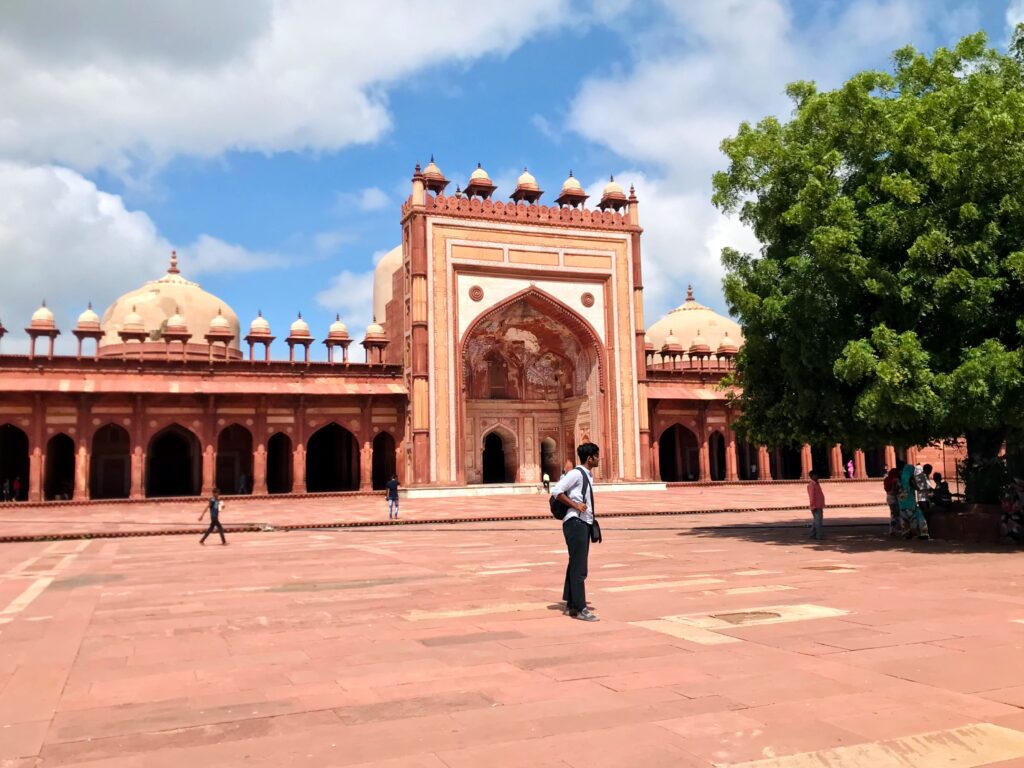
Emperor Akbar achieved great glory by establishing a town in honor of a saint, constructing a tower in memory of the saint’s elephant, and relocating his capital to this new site for the duration of his reign.
During my recent visit to Agra, I dedicated an entire day to exploring Fatehpur Sikri, a town founded by Emperor Akbar.
Let me share that Fatehpur Sikri was the first meticulously planned town built during the Mughal era. The name “Fatehpur” comes from two words: “Fateh,” meaning “victory,” and “Pur,” meaning “city“. It was named Fatehpur Sikri because it was constructed on the site of an existing village called Sikri.
In this guide to the Fatehpur Sikri , I will help you plan your perfect trip and share what you need to know, also what to do, how to get there.
In this travel guide to Fatehpur Sikri, you will find:
Table of Contents
- Akbar’s Gentle Character
- Prepare Yourself Before You Go
- Buland Darwaza: The Door of Victory
- Sheikh Salim Chishti Dargah
- Entrance to Fatehpur Sikri Fort
- Jodha Bai’s Palace
- Harmasara (stables) and Birbal’s Palace
- Panchmahal – Palace of Five-Storeys
- Diwan-e-Khas
- Turkish Sultana’s House and Girl’s School
- Anoop Pond
- Visitor Information
- Ticket Rate and Timings
- How to reach?
Akbar's Gentle Character
A question that comes to mind is why Akbar chose to build a grand city where a saint once lived. By doing this, he honored the saint and combined spiritual respect with his ambitious vision for the city.
Sheikh Salim Chishti, a renowned Sufi saint during Akbar’s reign, profoundly impressed people with his spiritual presence. He resided in the village of Sikri, near Agra.
During the period when Mughal emperor Akbar was expanding his empire with a series of victories, he enjoyed many blessings but lacked one crucial joy—having a child. This absence often caused him internal distress.
Ultimately, with Sheikh Salim Chishti’s blessings, Akbar’s wish for a child was granted, and he was blessed with a son. He named the boy Salim in honor of the saint, who later became known as Jahangir.

Prepare Yourself Before You Go
A brief 40-kilometer journey on the city bus took us from Agra’s Idgah to the Fatehpur Sikri bus station. After getting off the bus, we asked the conductor for directions to the Buland Darwaza, and he directed us to a narrow, steep path behind.
Buland Darwaza is right above the bus station, its wonderful.
A short climb and the towering Buland Darwaza came into view. It was so grand that I had to tilt my head back to see its peak. There were no policemen or tourism signs around, just goats and a few stray animals roaming the steps of the monument. The thing that surprised me the most was the presence of people sitting on the stairs. For a moment, I felt that everybody is a tourist but no these were probably locals.
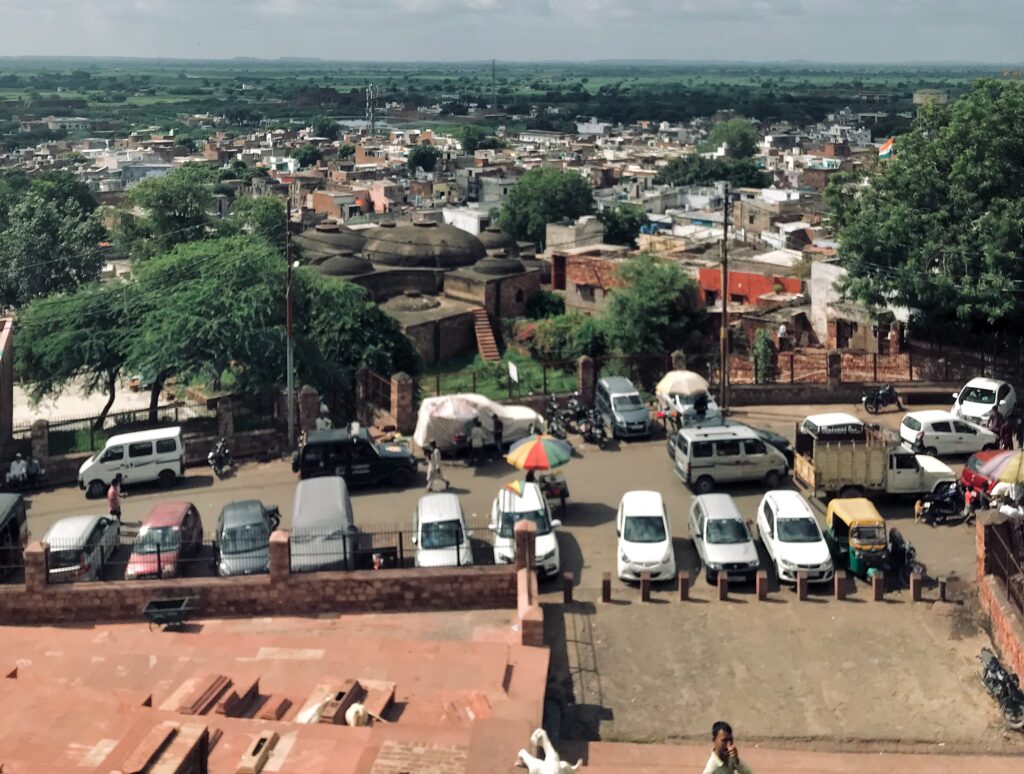
Buland Darwaza: The Door of Victory
Standing under the massive Buland Darwaza, I felt tiny—stunned and completely speechless. It is famous for being the world’s highest gateway. The structure was erected in 1602 to celebrate Akbar’s triumph over Gujarat. Measuring 54 meters in length and 35 meters in width, it serves as the grand entrance to the Jami Masjid (mosque).
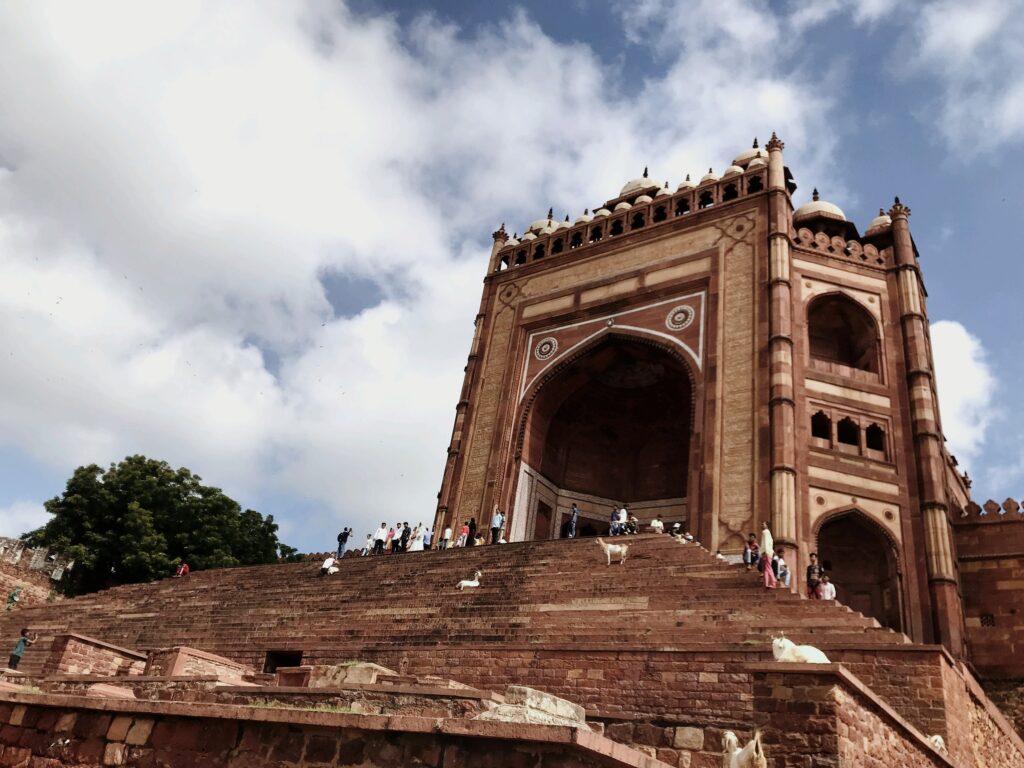
Constructed from red sandstone and adorned with white marble, this building is a superb example of Mughal architecture. It also reflects Akbar’s vision of religious unity.
Upon closer inspection, I noticed that the chhatris (the decorative domed pavilions) are designed in the Rajput style. The building features inscribed verses from the Holy Quran in Persian, and on the upper part of the door, there are a few lines attributed to the Lord Jesus.
In essence, the message is that human life is fleeting and we must eventually leave this world. Therefore, we should not view the world as our permanent home but instead dedicate our time to devotion to God.
Sheikh Salim Chishti Dargah
I left my shoes at the entrance and stepped inside. The first thing I noticed was a pristine white marble tomb encased within the surrounding red sandstone architecture. As depicted in pictures, this is the mausoleum of Sheikh Salim Chishti.
Thanks to the blessings of this saint, Emperor Akbar was granted a son. Sheikh Salim Chishti was a revered religious teacher, and in his honor, Akbar constructed this dargah. Today, it is a place where thousands of devotees come to make vows and tie threads as offerings.

Directly opposite the dargah is the Hauz tank, a sacred water reservoir.
After washing my hands there, I entered the dargah and walked around the tomb, admiring the intricate carvings on the white marble.
When I came out, I found a group of people singing qawwali infused with the melodies of Sufi music. I joined them and sang a few lines myself. To the right of the dargah are additional tombs belonging to the family of Salim Chishti Saheb. Nearby, the Jamia Masjid stands, where some people were leisurely sunbathing within its grounds.
After a few moments of reflection, I picked up my shoes from the entrance and left through a different gate to the right of the Buland Darwaza, known as the “Badshahi Darwaza.” This was the very door that Emperor Akbar used to enter the Jamia Masjid.
Entrance to Fatehpur Sikri Fort
After a short 2 minutes walk, we reached the fort.While I was booking tickets online, I began reading the information about the palace inscribed on stone. An elderly man then approached us, displaying an ASI (Archaeological Survey of India) badge on his shirt pocket. He offered to give me a tour of the entire fort for ₹300. When I declined politely, he reduced his price to ₹200, but I still declined and continued on my way.
As you enter, you can choose to go either to the “Stables” or to “Jodha Bai’s Palace.” I opted to visit the palace first, although it doesn’t matter which path you take, as both routes eventually converge inside.
It’s a good idea to take a rest under the shade of the trees here, as you won’t find much shade inside. I decided to do so.
My first stop was…
Jodha Bai’s Palace

The inscription at the palace entrance indicates that it was likely built between 1570 and 1574 and functioned as Akbar’s main harem, though it is often mistakenly called Jodha Bai Mahal. As I entered, I saw a plant in the center of the courtyard. Someone mentioned that it used to be a Tulsi plant.
The palace is enclosed on three sides, featuring a square courtyard and several rooms. From the verandah to the west, supported by pillars, I observed small drawers built into the walls where idols of deities were displayed, and a platform in the center that once held the main deity’s statue.
The palace is designed in the Rajput style, reflecting Akbar’s allowance for Jodha Bai to practice her religion freely and live comfortably. It is likely that Jodha Bai resided here with her maids. To the left, a documentary film was being shown, though it seemed to capture little interest from the other tourists. I decided to watch it for a while.

Harmasara (stables) and Birbal’s Palace
Jodha Bai’s kitchen, where she cooked for Akbar, was situated close to the drinking water taps. Moving forward, I entered an open area with a charming, small building standing at the entrance of the hallway.
Two inscriptions indicated that the area was used as a dwelling place for elephants, horses, and camels. Upon entering one of the stables, I discovered a spacious hall accessible through a small door. This large area was likely designed to shelter the animals from rain and bad weather, or to accommodate the staff responsible for their care.
The striking building in the center was Birbal’s Palace, which is part of the Harmasara complex. It is believed that Akbar’s other Begums, Rukaiya Begum and Salima Sultana Begum, also resided here.
The palace is a double-storeyed structure with four rooms on the lower level and two rooms on the upper level. The intricate carvings and the elegant arches on the upper part of the building add to its appeal.
Panchmahal – Palace of Five-Storeys
The Panchmahal, also known as the Badgir, translates to “palace of five floors.” This grand structure is supported by a total of 176 pillars, arranged in descending numbers from the ground up: 84 on the first floor, 56 on the second, 20 on the third, 12 on the fourth, and 4 on the fifth.

When I went beneath the first floor, I was amazed by the orderly arrangement of the columns. This palace, used for entertainment and relaxation, was a favorite spot for Emperor Akbar to enjoy the evening breeze and moonlight. The third floor connects to the harem, allowing the Begums and royal women to visit discreetly. There is a pond directly in front of the palace, which I’ll describe later.
Diwan-e-Khas
I recall reading about the Dewan-e-Khas and Dewan-e-Aam in history books during school and imagining their grandeur and design. Now when I see them with my own eyes, it feels different.
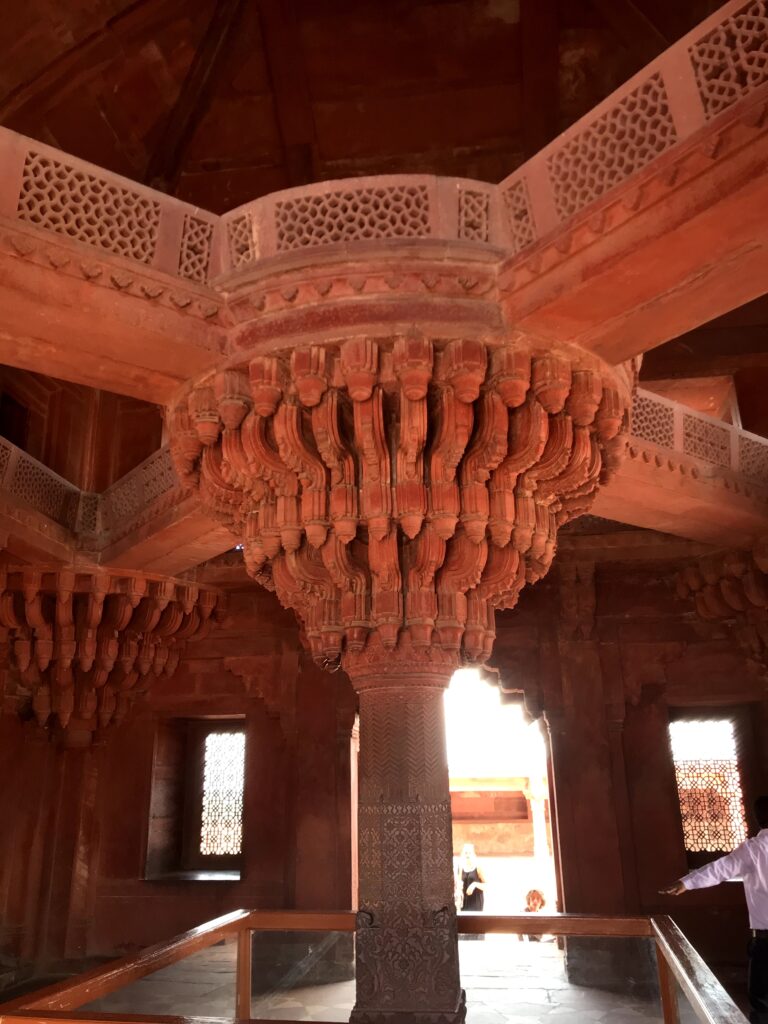
Some refer to it as a pillar of justice, while others view it as a place of worship. However, based on what I’ve read, it was actually used by Akbar for important discussions and decision-making with his wazirs.

Upon entering, a column adorned with breathtaking artwork stands prominently in the center. Akbar would sit on his throne above this pillar, while four wazirs or advisors took their seats at its corners. The column’s intricate details are truly mesmerizing at first glance.
Turkish Sultana’s House and Girl’s School
In terms of carvings, it’s safe to say this building is the finest in the entire fort complex. It truly made my eyes light up.

It connects to another building via a verandah, which served as a girls’ seminary or school providing education.
Anoop Pond
This 30-square-meter pond is enclosed on all sides, with a jagged platform in the center. There are four pathways leading to the platform.
We’ve all heard about the legendary musician Tansen, who was said to make clouds burst and spices burn with his singing. While I can’t verify the truth of these stories, this location was indeed used for festivals and cultural programs.
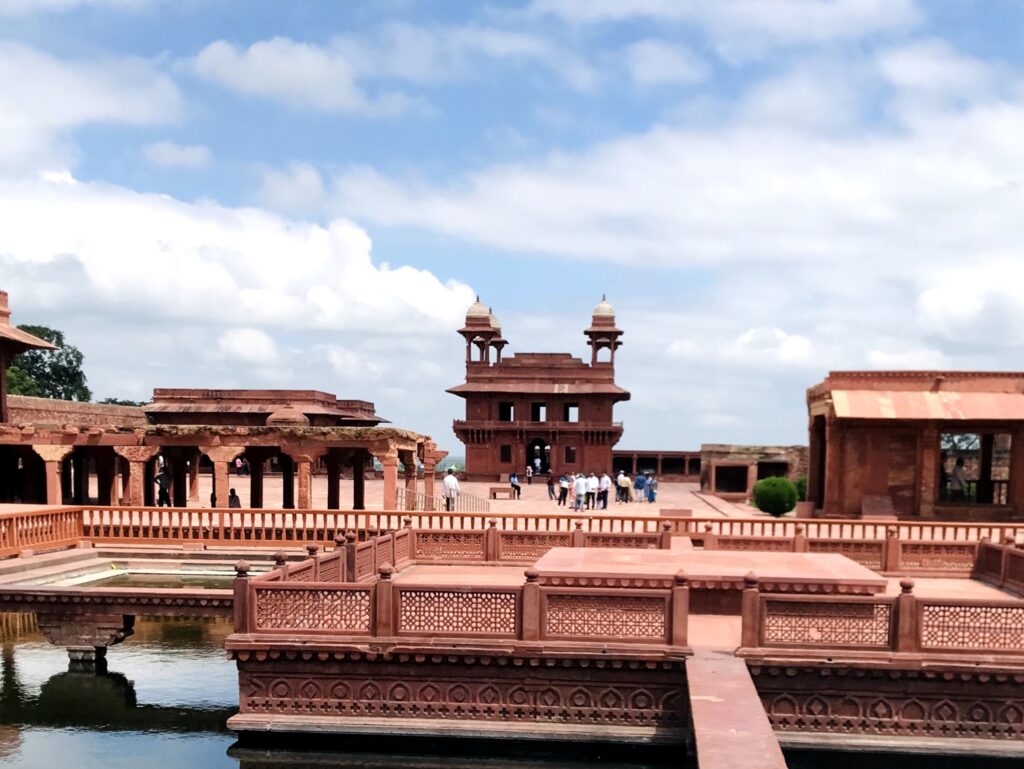
Tansen also performed ragas here, while Akbar enjoyed the music from the top floor of the Panchmahal with his Begums. Having read and heard many legends about Akbar and Tansen, it’s truly a privilege to visit this place now.
Visitor Information
Entry Points: Use Buland Darwaza (near the bus station) for Jodha Bai’s palace or Agra Gate (right as you enter Fatehpur) if driving.
Travel Tips: Wear comfortable shoes, bring water, and be prepared for lots of walking.
Guides: Hire from the Archaeological Survey of India at the ticket counter; negotiating is possible.
Security: Keep a close watch on your belongings.
Dargah Visit: Cover your head with a handkerchief or cloth. Photography is restricted inside Sheikh Salim Chishti’s tomb but allowed elsewhere without extra charges.
Ticket Rate and Timings
| Timings | Sunrise to Sunset |
| Cost | Indian tourists, tourists from SAARC country: ₹ 35 (+5 per person, tax to be paid). Foreign tourists: ₹ 550 Admission for children under 15 is free. |
How to reach?
Agra and Fatehpur Sikri are part of the Golden Triangle with Delhi and Jaipur, making access to Fatehpur Sikri quite convenient. The distance from Agra to Fatehpur Sikri is just 43 km. You can reach here using the following methods:
By air
The nearest airport is Agra’s Kheria Airport, but it has limited flight options. It’s better to fly into Jaipur Airport (200 km) or New Delhi Airport (250 km). From Delhi or Jaipur, you can take a bus, cab, or train to reach Agra and then continue to Fatehpur Sikri.
By train
Agra has two main railway stations: Agra Fort Railway Station and Agra Cantt. Trains from both stations connect to various parts of the country. Additionally, Tundla Railway Station, which is close to Agra, also serves the area.
By road
Agra is located 240 km from Delhi, 200 km from Jaipur, and 370 km from Lucknow. The main bus stations in Agra are Idgah Bus Station, ISBT Agra, and Power House Bus Stand. From Agra, you can take a bus, taxi, or cab to reach your destination.

I hope you found this article helpful and informative. If there’s anything I may have missed or if you’d like to share your thoughts, please let me know in the comment box below. I am always keen to improve and value your feedback.


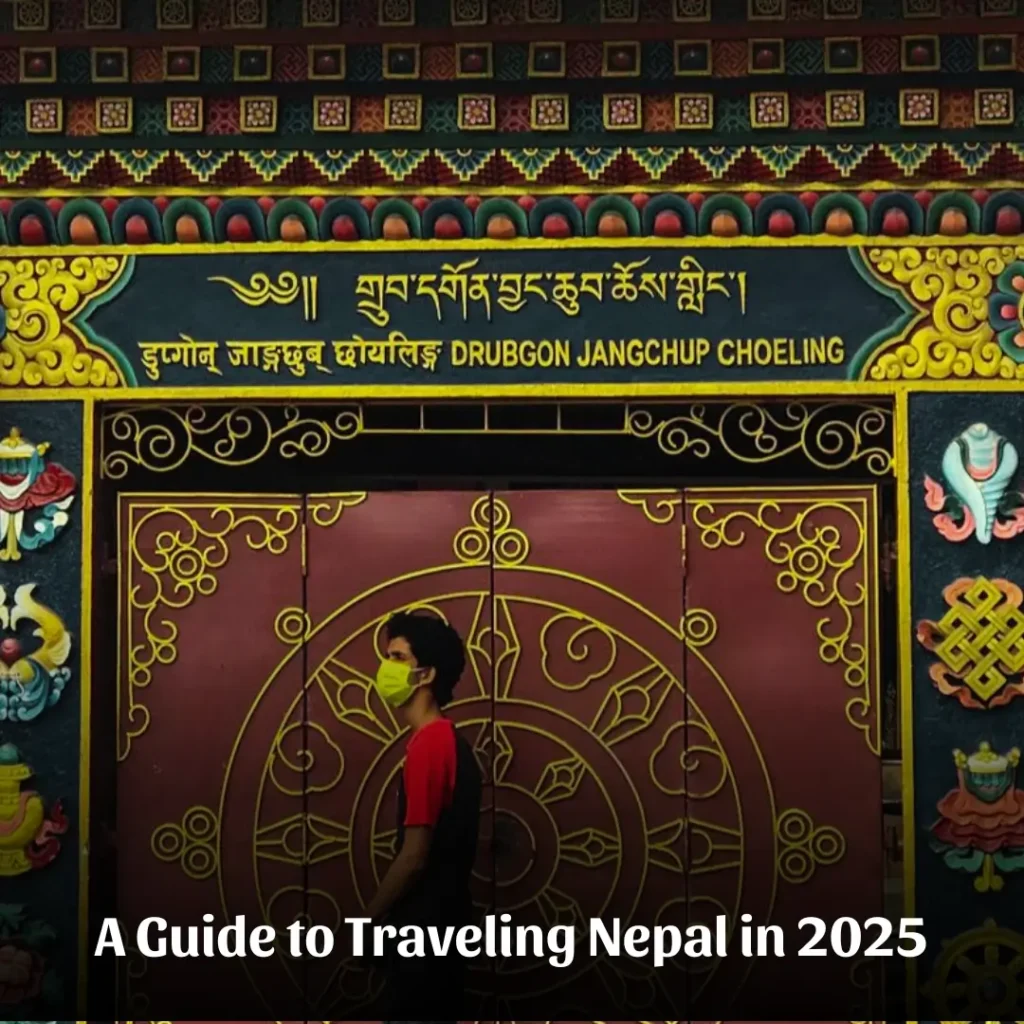
Very Informative! Would like to go there soon after knowing it’s rich history.
Superb layout and design, but most of all, concise and helpful information. Great job, site admin. Take a look at my website Webemail24 for some cool facts about Search Engine Optimization.
I couldn’t resist commenting